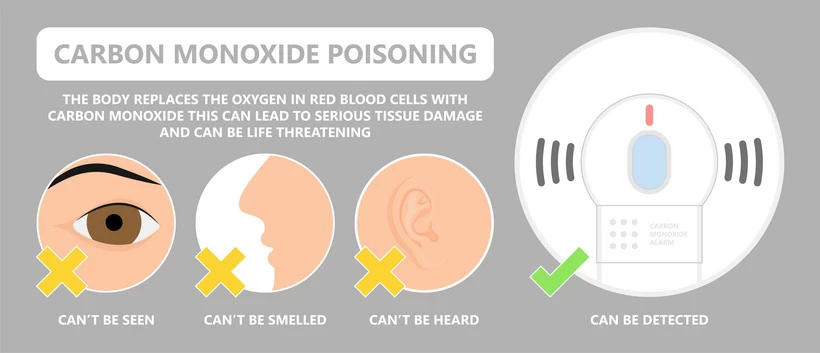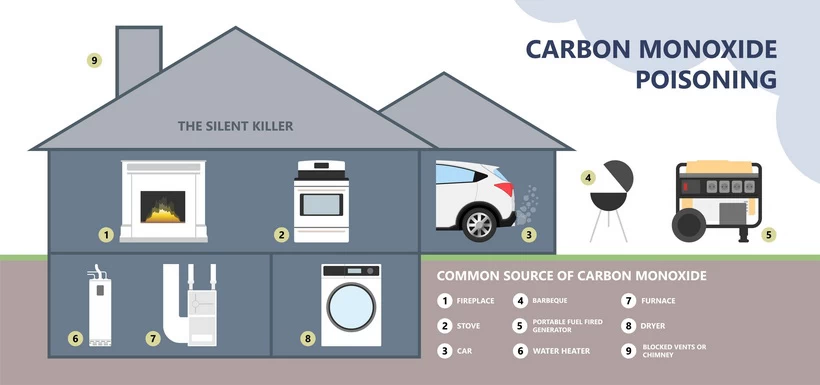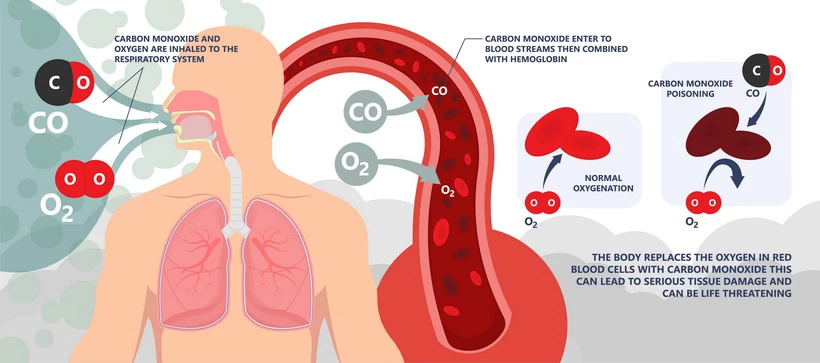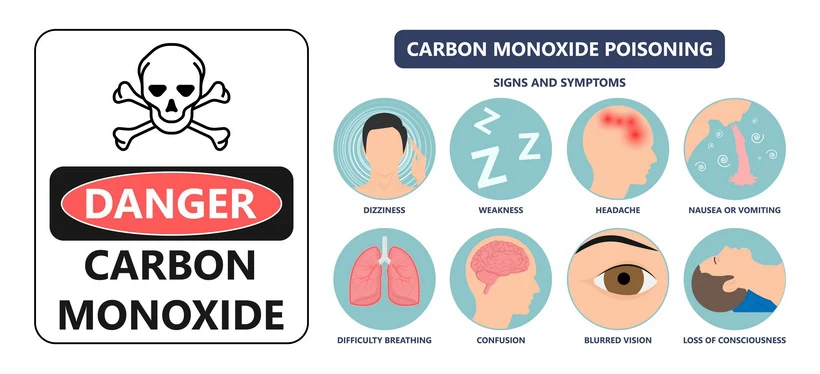Carbon monoxide detectors are essential in every home. They can save your life by detecting the presence of this deadly gas before it’s too late.
CO detectors go off for a reason – they’re trying to save your life! But what do you do when they start beeping? Most people have no idea and just turn them off or take the batteries out. Don’t make that mistake!
We want to help you be prepared in case of a carbon monoxide emergency. That’s why we’ve put together this guide on everything you need to know about carbon monoxide detectors. From how they work to where to install them, we’ve got you covered.
Read our complete guide on carbon monoxide detectors now!
What is Carbon Monoxide?
Carbon monoxide (CO) is a colorless gas that is odorless, tasteless, flammable, highly poisonous and has a density slightly less than air. It is the simplest member of the oxocarbon family that contains one carbon and one oxygen molecule.

In most cases, the main source of carbon monoxide generation is the partial combustion of carbon fuels or compounds, particularly in internal combustion engines. The partial conversion happens due to a lack of an adequate amount of oxygen or heat that would otherwise produce carbon dioxide instead of CO.
Many other biological and environmental sources produce and emit CO, which is used in producing many fragrances, drugs, and fuels.
The Clean Air Act of 1970 and its subsequent amendments were passed to ensure suitable action in the fight against environmental pollution. The National Ambient Air Quality Standard (NAAQS) was established by Environmental Protection Agency (EPA). NAAQS addresses six pollutants that threaten public health, of which CO is one.
Sources of Carbon Monoxide
As stated above, it is formed by the incomplete burning of fuels like gas, coal, oil, wood, or kerosene. It can be produced by fuel-powered appliances like furnaces, water heaters, space heaters, gas ranges, clothes dryers, ovens, wood-burning stoves, or fireplaces.

A poorly ventilated space, malfunctioning appliance, or clogged chimney can lead to carbon monoxide buildup inside your house. Lack of fresh air can further aggravate the problem for children, the elderly, and people with lung and heart problems.
As per Environmental Protection Agency (EPA) website, the average level of CO in any home without a gas stove is between 0.5 to 5 PPM. Levels in homes with properly adjusted stoves are between 5 to 15 ppm, while those with poorly adjusted stoves may have more than 30 ppm.
Why is carbon monoxide dangerous? What causes carbon monoxide poisoning?
This brings us to the all-important question about the ill effects of carbon monoxide exposure. The red blood cells show a preference for absorbing carbon monoxide over oxygen molecules. CO combines with the hemoglobin to form a compound known as carboxyhemoglobin (HbCO) and impairs the blood’s ability to carry oxygen and expel carbon dioxide. In addition, it impacts hemoproteins, which in turn affect cellular operations.

Exposures of 100 PPM or more of CO are dangerous to human health. OSHA recommends an average value of 50 PPM over an eight-hour period as the long-term workplace exposure limit OSHA requires vacation of any confined space if the upper limit of 100 PPM is reached. Even continuous exposure to 35 PPM may result in headaches and dizziness.
Tell me the symptoms of CO poisoning.
The effects and carbon monoxide poisoning symptoms vary with individuals, CO concentration, and exposure duration. However, small exposures cause flu-like symptoms, including headaches, dizziness, weakness, vomiting, loss of judgment, confusion, etc. Unfortunately, these symptoms are either not understood or do not evoke a serious response.

Large exposures can lead to loss of consciousness, convulsions, respiratory arrest, seizures, nervous system damage, and even death.
Long-term CO exposure manifestation includes memory loss, continuous fatigue, difficulty in movement, etc. Please see this safety guide from Consumer product safety Commission about Portable generators.
General precautions in using fuel-burning appliances
We highlighted the importance of proper ventilation, ensuring that the chimneys are not clogged, and any fuel-burning appliance is functioning properly.
You must ensure that any portable power generator, charcoal grills, etc., are never used indoors, in the basement, in a crawlspace, or in your closed garage. As advised in our article on “How To Start A Generator?” the portable generator must be placed at least 20 feet away from your house, doors, or windows, and the fumes must be pointed away from them or any other nearby people.
If you are experiencing symptoms like a slight headache when these appliances are running, go out in the fresh air, away from the generator.
How do carbon monoxide detectors work?
For your own and the safety of your family members, it is always recommended to install carbon monoxide in your home. These CO detectors must be battery operated, or at least battery backed up, as these may be required to operate during a power outage when your portable generator is working.
A CO detector measures the levels of carbon monoxide over time and gives an alarm when they exceed unsafe levels to warn people to evacuate the area. As per Underwriters Laboratories, these are available in two forms.
- CO safety alarms as per the standard UL 2034
- CO detectors, passive indicators, and system devices as per UL 2075.
The alarms on CO detectors are of concentration time function type, which implies that if lower concentrations of CO are detected, the alarm will sound after a longer duration than if it senses a higher concentration. For example, at 100 PPM, the detector may take tens of minutes to sound, while at 400 PPM, it may do so within a few minutes. The purpose is to prevent false alarms if the CO levels exceed for a short time due to cigarette smoke or similar reasons.
A CO detector is a simple device housed in a plastic shell and carries a microchip and a detection chamber carrying a CO sensor. It may also include a power indicator light, an LCD display, and a test button.
You can use CO detectors as stand-alone models or choose to connect them to the system of monitor devices. As part of a connected system, they are wired to a security or a fire alarm panel and get monitored by a central station. The central station needs to send proper authorities to investigate if alerted by these panels of higher levels of carbon monoxide.
You must properly understand that the detectors are a backup designed to warn you of the unusual buildup of CO in your house and not a replacement for a properly installed and maintained fuel-burning appliance.
Types of CO Sensors
Four main types of sensors are available in the market, having different costs, accuracy, and speed of response. Further, these sensors cannot be replaced in most cases and define the detector’s life.
A. Opto Chemical Type
This type of sensor is a low-cost option that only provides a qualitative warning. It carries a pad of a colored chemical. When the chemical reacts with carbon monoxide, its color changes.
B. Biomimetic type
This sensor mimics the effect of carbon monoxide on hemoglobin. It uses a gel that changes its color on the absorption of CO. A separate source of infrared light (IR LED) is used along with a photodiode to sense the CO levels. They have higher costs but provide reliable results.
Hence, these are used in high-end applications and RVs. The battery life of conventional alkaline type is 2 to 3 years, while the lithium battery can match the lifespan of these types of sensors which is around six years
C. Electrochemical type
This type of sensor works on the fuel cell principle, which converts the chemical energy of a fuel and that of an oxidizing agent into an electrical current using reduction-oxidation (redox) reactions. CO is oxidized at one of the electrodes producing carbon dioxide and consuming oxygen and the other electrode. This sensor gives highly accurate readings that exhibit a linear variation with the levels of CO and has a higher lifespan of about 7 to 10 years.
D. Semiconductor type
Metal oxide semiconductor sensors (mostly using Tin as the metal) are placed on an insulated ceramic base. This sensor is monitored by an integrated circuit. Carbon monoxide’s presence reduces the metal oxide’s resistance, while oxygen increases it. The integrated circuit monitors the resistance level and acts beyond a preset limit. The unit requires more power than other sensors and must only be fed from the mains.
Detectors with a digital display and portable types of detectors are available in the market.
Tell me the typical CO alarm life. How long does a CO alarm last?
As stated earlier, any CO alarm’s life depends on the life of the sensor it uses, whether it is powered by AC mains, battery, or both. Certain types of battery-powered devices can provide a battery life of about 10 years. The list below gives general lifespans based on the technology used to give you an idea. However, individual makes and models may have different actuals. You need to check the manual of the actual CO alarm for the specific value.
- Semiconductor-type sensors have a typical lifespan of around five years.
- The Electrochemical type sensors can last between 7 to 10 years.
- The biotechnology-based sensors have a useful life of about six years
Is CO heavier than air? What is the diffusion of CO in the air?
Carbon monoxide is slightly lighter than dry air and has a density of about 97%. Since the density is very close to the dry air, CO can easily diffuse and get evenly distributed in the air.
Tell me the best place to install a CO detector.
Without any consideration for the size of your house, you must place a CO detector on every floor of your house, including the basements, near every sleeping area within a distance of 10 feet from the bedroom doors and over and near every garage. For added protection, you may install a detector in each of your bedrooms.
It is usually recommended to install them at a minimum height of about 5 feet from the finished floor level, which will match your breathing level. However, you may go for the ceiling if you prefer, but take care to maintain at least half feet distance from the wall.
Is there anywhere I shouldn’t install CO alarms?
You can read the section below on reasons for false alarms by the CO detectors, which will give you a clear idea about the areas where it is not recommended to install them.
Can I test my CO alarm using a different method than using the test button?
The test buttons on a CO give you information about the healthiness of the battery, buzzer, and electronic circuits. They do not confirm its ability to sense the presence of CO gas.
You should never try using vertical exhaust or other combustion fumes to test your detector. These are harmful fumes and can even permanently damage the detectors and impact your warranty.
Normally the owner’s manual will recommend some form of canned CO tester, usually a nonflammable aerosol. The recommended sprays contain CO below the dangerous levels. Follow the procedure as recommended by the manufacturer.
Why does the red light flash on my CO alarm? Do I have CO?
In many makes like First Alert, the red light indicates the availability of the battery power to the detector for its proper working. So it is a sign of the healthiness of the detector. Anyway, always check with your owner’s manual for the correct interpretation of the signals.
Patterns of CO Detector Beeping
You should go through the user manual to familiarize yourself with the carbon monoxide alarm beeping patterns and their interpretations. In general, the following patterns of alert signals are followed and prescribed by NFPA.
- Four Beeps and a pause: Four pulses temporal patterns made up of four beep cycles of 100 ms beep ON period followed by 100ms of OFF period. These periods of 100 ms may have a tolerance of 10%.
- Each of the above four beeps is followed by the silence of five seconds before the next four beeps are initiated. This pattern is followed for four minutes before the off time between full beeps gets increased.
- Five beeps per minute: This pattern indicates that your detector is reaching its end of useful life and needs to be replaced.
- Three beeps per minute: This indicates an internal fault within the detector that may require replacing detector.
- One beep a minute: This signifies low batteries and the need to replace them.
Why Is My CO Alarm Going Off?
If your carbon monoxide alarm is going off, never assume that it is a false alarm you have to take action immediately for your safety. We have already explained earlier that CO is a silent killer, so you should always presume that the detector is doing its job properly and take action, as highlighted below.
- Keep your cool and open windows and doors.
- If it is safe to do so, turn off any fuel-burning appliance, gas stove, central heating, cookers, etc.
- Take everyone in your family outdoors for the fresh air.
- Contact emergency services or the local fire department.
- Check if any of your family members show signs of CO poisoning, like headaches or dizziness.
- Inform your neighbors and landlord as there is a possibility of the gas leak into their premises.
- Do not re-enter the premises unless the qualified technician from the emergency team has thoroughly investigated, identified the reason, and taken steps to prevent further carbon monoxide generation.
Why Your CO detector is giving out false alarms?
There are several reasons that may lead your CO detector to trigger false alarms, as listed below:
- Excessive moisture: These detectors are susceptible to moisture and must be installed at least 10 feet away from humid areas or areas where steam is available, like showers, saunas, dishwashers, laundry rooms, close to installed humidifiers, etc.
- Fuel-burning appliances: Any fuel-burning appliance, like a stove, water heater, furnace, etc., produces trace amounts of CO even in its best-maintained condition. Hence it is recommended to install carbon monoxide detectors at least 15 to 20 feet away from such appliances or in the air stream of the kitchen.
- Lead acid batteries: Flooded-type lead acid batteries produce a high volume of hydrogen gas, particularly during charging, which may trigger the CO alarm.
- CO sensors should not be exposed to direct sunlight.
- There is a carbon monoxide leak from your neighbor’s premises through the walls, floors, or common space. If your house is on a very busy road or highway, traffic fumes from the road may enter your house.
The batteries need changing, or the device is faulty
As stated earlier, most CO detectors have a different beep pattern for certain internal and battery faults, which will alert you to replace the battery or the detector itself.
Why didn’t the emergency responder find CO gas after an alarm?
If you had taken actions like shutting down the fuel-burning appliances that produce carbon monoxide and opening your windows and doors, the concentration levels can come down. In another scenario, the CO might have entered your premises from the neighborhood and stopped since.
You need to open the doors and windows for your safety at the earliest if you cannot exit the premises immediately. The response team can find other ways to recreate the scenarios in their effort to locate the source of the gas.
How to reduce or prevent CO exposure
The following simple steps and actions will considerably reduce exposure to high levels of CO gas.
- Ensure that compression equipment is always adjusted and maintained.
- Manage vehicular traffic around the residential buildings and parking. Add additional ventilation if there are higher levels of CO for shorter durations.
- Go for a vented space heater.
- Use an exhaust fan over the gas stoves and vent them to the outdoors.
- Use only the properly sized wood stoves meeting the EPA standards for emissions. Ensure all the doors of the stove are tightly fitted.
- Ensure all the flues are open when you are using the fireplace.
- Use only the proper fuel in the kerosene space heaters.
- Never idle your car in the attached garage.
- All central heating systems, including the furnaces, flues, and chimneys, are inspected annually by a trained professional, and any leaks are attended to promptly.
Conclusion
Carbon monoxide detectors are an important part of any home safety plan. They work to save lives by detecting the presence of carbon monoxide gas and sounding an alarm to warn people in the home of the danger. CO alarms can be life-saving, but only if they are working properly and installed correctly.
This post has answered some common questions about carbon monoxide detectors and what to do if your alarm goes off. Please let me know in the comments section below if you have further questions or need help installing a detector.
